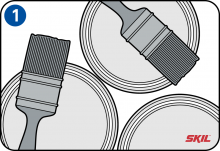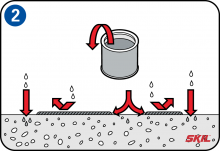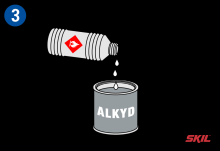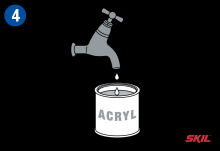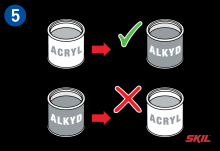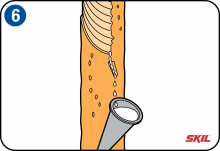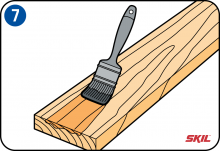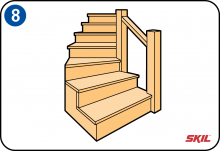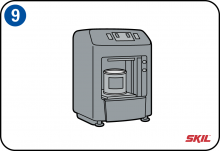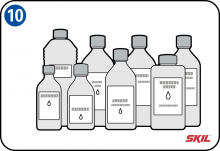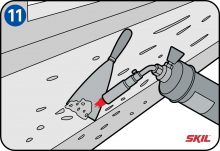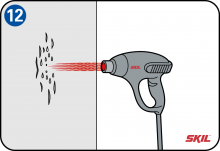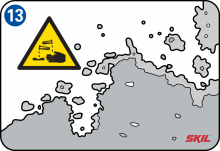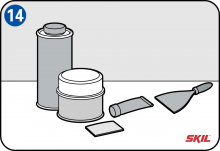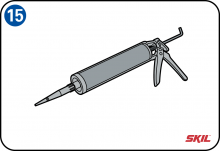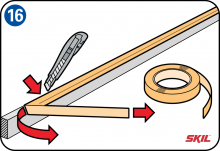-
Undercoat – the basis
For better adhesion and coverage, you should first use an undercoat or primer. This has special characteristics which differ from the top coat, and it is vitally important for a good result. Most important, the primer reduces the absorption of the underlying material for better adhesion. The primer also prevents any dirt from reaching the finishing coat. On a metal surface you should use a special undercoat or rust-resistant primer.
-
Special primer for walls
If you want to paint a wall, untreated masonry or concrete followed immediately by a finishing coat, the paint is absorbed strongly by the wall. This is because the wall is porous. The final result will not look very good, because it will not have enough coverage and overlap or the roller. It’s best to first apply a primer. You can use a primer for plasterwork, plaster panels and brickwork. The primer also prevents penetration of nicotine, cooking fat, surface soiling, dried water stains or marks from children’s felt-tip pens on the wall. You won’t see any of these undesired effects if you use a primer.
-
Alkyd paint
Alkyd paint or synthetic paint can be used both indoors and outdoors, has a 40-50% turpentine basis and can be thinned with turpentine. It won’t adhere to acrylic paint, and is available in satin or gloss finish. Alkyd paint can be overpainted after 16 hours.
Professional painters often use alkyd paint for a good final result. The next-to-last coat is often painted with a mixture of 50% undercoat and 50% finishing coat. Satin-finish paint has a less glossy appearance. Clean you tools after use with turpentine.Fading
Alkyd resin which is used in this kind of paint will gradually suffer from fading. The binder that it contains suffers from discoloring through UV or lack of light. You can recognize this by the darker and lighter sides, for example on your furniture and on the inside of cupboards and door frames. High-solid paint has a very high pigment content, which gives it a more solid composition and good covering power. -
Acrylic paint
Acrylic paint is mainly used indoors, and is less suitable for outdoor use. It lasts for around 4 years. This kind of paint is based on 5-10% turpentine, and can be thinned with water. It has a reasonably good adhesion to alkyd paint, and can be applied with a special brush or roller. This paint is dry after 6-8 hours, and can be overpainted in thin coats. Acrylic paint is available in satin and standard gloss finish (not really high-gloss such as alkyd paint).
Acrylic paint has the advantage that it can be mixed with water. It has no solvent smell, it dries quickly and is not subject to fading. However you need to be able to work quickly and accurately: when you’ve applied a coat of acrylic paint, you can’t touch it any more (so it can’t be ‘smoothed’ when you’re finished!). You can only apply acrylic paint at temperatures of between 8C and 25C. You can clean your tools after use with warm water and detergent.
-
Overpainting
Acrylic paint can be applied over alkyd paint after you’ve sanded it well. But not the other war round! So if you’ve used acrylic paint, you have to keep on using acrylic paint afterwards. And if you want to go back to using turpentine-based alkyd paint, you’ll have to remove the entire acrylic coat first. In most cases you’ll have to do that by scraping it off manually or by burning it off, or in the worst case you’ll have to use paint stripper.
-
Latex paint
Latex paint got its name in the 1940s, and stands for paint with a natural latex emulsion component (liquid rubber). Latex was originally a natural product from Brazilian rubber trees (Hevea brasiliensis). The sap of the Hevea tree is the product from which genuine rubber is made. Nowadays this natural latex is no longer used in latex paint. The paint manufacturers now use synthetic polymer for acrylic and vinyl paint. Today’s ‘latex’ paints have a completely different chemical composition and characteristics than traditional latex rubber. So ‘latex paint’ isn’t really the right name for water-based paint, and in fact it is based on acrylic paint.
-
Varnish
Transparent varnish: this varnish gives the wood surface a colored finish while the transparent finish still remains visible and the wood can breathe.
Opaque varnish: this varnish covers the wood surface, so the wood structure is no longer visible and the surface is protected. As well as transparent, this varnish is also available in numerous different colors. It can also be mixed in a mixing machine. Transparent varnish is also available in a choice of specific wood finishes such as Teak, Pterocarpus and Shorea (Meranti). This allows you to combine a decorative effect with protection of the wood. Varnish can be used directly as 1st coat, but should then be diluted after 10% thinning. Sand lightly between the coats. -
Transparent paints and lacquers
Transparent paint systems and lacquers are less resistant to the influence of ultra-violet (UV) light. There is enough protection on the top surface, but under that protective coat the wood can be affected by rot, although in practice this will be easily visible. This paint is available in both acrylic and alkyd. Varnish for parquet floors or stairs is the most durable option for transparent coatings on wooden floors and stairs.
-
Color mixing machine
Mixing machines have become essential items of equipment in specialist stores. Mixing uses a number of basic colors with pigment pastes. Mixing of the basic colors and the quantities of the pigment paste to make the desired color is controlled by a computer. The color that has been prepared can then be re-ordered again later if desired. Virtually any desired color can be produced, and the colors can be coordinated for a perfect match. You can also refer to the standard color swatches of the manufacturer or the international RAL color system.
-
Solvents
Solvents are intended for dissolving and thinning of paints and varnishes. They are still widely used in paints for wooden surfaces. They easily evaporate, and can have harmful effects for health and the environment. Commonly used solvents include turpentine, alcohol, acetone, white spirit and thinner. Water is the most widely used ‘solvent’ for acrylic paint.
-
Overpainting of old paint coats
Before you apply a new paint coat, you need to know which kind of paint has been used. If you’re using the same kind of paint, then it’s enough to sand it and then to fill the holes and other imperfections with filler. If you want to make the original wood visible again, or if you to paint over acrylic paint with a new coat of alkyd paint, then there’s no alternative but to completed remove the old paintwork with a burner, heat gun or paint stripper.
-
Heat gun
A heat gun is an excellent tool to remove old paint coats. The heat softens the old paint, so it’s relatively easy to remove it with a paint scraper. Take care that you don’t breath in the hot paint vapors, and that you don’t burn the surface of the wood. If you have to remove several thicker layers of old paint, a Multi-Stripper with a cleaning disk is a good solution.
-
Paint stripper
If you find using a heat gun is rather difficult, you can also use paint stripper. This is very effective on synthetic paint, but doesn’t work so well on acrylic paint. Paint stripper can remove several coats at once, if you allow enough time for it to take effect. You should use a face mask and protective gloves. Remove the old paint coat before it hardens.
Take care! If there are any remaining droplets of paint stripper on your clothes, make sure they don’t come into contact with your skin. If that happens, stop working and rinse your clothing with plenty of clean water. After removing the old paint coat, clean the underlying surface thorough with water and allow it to dry before you apply the new coat. Make sure the area in which you are working is well ventilated and keep children away from your working area. -
Fillers
If you have damaged areas, gaps, cracks and other imperfections, repair them with filler (elastic filler if necessary). If there’s a crack, first open it up and enlarge it, otherwise you won’t be able to use enough filler for it to stick and the crack will soon reappear. After drying, sand lightly. If you’re using untreated wood, fill any splits and cracks with wood filler of the same color.
-
Žingsnio patarimas
Use plastic wood and mix it with sawdust for an almost invisible repair in the same color. -
Sealant
Use paintable acrylic sealant to fill any imperfections between the walls and window frames. Don’t use silicone sealant because the paint won’t stick to it. Wait until it is dry, then carefully sand it smooth. If necessary use a primer to ensure complete coverage. Clean the ways if they are soiled or greasy with ammonia, especially in a kitchen or bathroom. Use a damp cloth to remove dust from the tops of doors and window frames and the door openings. If you’re using sealant in the bathroom or other wet areas, it’s best to use an anti-mold sealant. This will prevent the familiar black mold.
-
Masking tape
If you want to use masking tape, use good-quality painter’s tape, which is usually blue or green. Apply it in short, overlapping strips, and press it on firmly to ensure secure edges. It’s best to remove the tape immediately after painting. It’s best to do this before the paint is completely dry, to prevent the painted edge from crumbling off. If the paint is dry, remove the masking tape smoothly from the surface at an angle of 30°-45°. If some tape is still left over, you can gently cut if off on the painted side with a sharp hobby knife.
-
Some other examples of different kinds of paints
Some other examples of different kinds of paints:
• Special wall paint for damp rooms
Especially to prevent mold for rotting on single-brick walls.• Magnetic paint
This paint contains metallic particles, so you can fix magnets to the surface for notes and memos.• Blackboard paint
So can make notes and drawings on it using chalk.• Luminous paint
Absorbs light and emits it again in the dark. The luminous effect disappears after a while, but it returns after the surface is illuminated again.• Aerosol paint
Paint out of an aerosol can has excellent filling, covering and adhesive properties. It can be used for both treated and untreated surfaces, made of wood, metal, aluminium, glass, stone and different kinds of plastic. Handy for use in hard-to-reach places.

